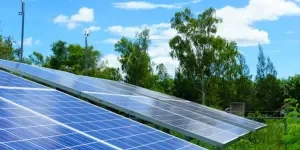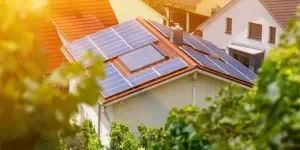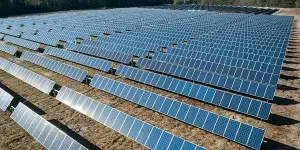With the ongoing transition to renewable energy, demand for sine wave inverters is on the rise. Customers need these inverters to convert direct current (DC) power generated from solar panels or stored in batteries to alternating current (AC) for use by home appliances and commercial purposes. This demand creates an opportunity for businesses in the energy sector to deliver quality, affordable sine wave inverters to their target markets.
This blog provides a comprehensive guide for selecting the best sine wave inverters to sell in 2023.
Table of Contents
Why do sine wave inverters have business potential?
Types of sine wave inverters
Tips for selecting the best sine wave inverters to sell
Leading markets for sine wave inverters
Conclusion
Why do sine wave inverters have business potential?
There are two main types of inverters classified by output waveform, including square wave inverters and sine wave inverters. While both types are used to convert solar DC power to AC power, their features and functionalities are different.
Sine wave inverters are more popular since they produce high-quality, sinusoidal waveforms suitable for sensitive equipment or loads. On the contrary, square wave inverters produce large harmonic content that may cause interference, making them unsuitable for some loads.
In addition, the growing demand for clean, reliable, and efficient power sources is driving the demand for sine wave inverters. They are needed to convert DC power to AC for use at home and businesses.
Sine wave inverters’ market size and potential
The sine wave inverter market has grown steadily over the past several years, a rise that is expected to continue due to increased global demand for uninterrupted power and the transition toward renewable energy.
The global power inverter market was valued at US $76 billion in 2022, and is projected to grow at a CAGR of 5.3%, reaching US $104.8 billion by 2028. In addition, the solar inverter market value was estimated at US $ 12.1 billion in 2021, and is projected to grow at 5.78% of CAGR from 2022 to 2029, potentially reaching nearly US $18.97 billion. While these numbers are not specific to the sine wave inverters, they reflect the massive market growth and potential of the inverter market.
Factors driving demand for sine wave inverters
There are various factors driving the global demand for sine inverters, including:
- Increased use of renewable energy sources, which require power inverters to convert DC power to AC
- Demand for backup power, especially in regions with frequent power outages or unstable power grids
- Growing perception of sine wave inverters as a potential solution to environmental concerns. This is because sine wave inverters are more eco-friendly.
Types of sine wave inverters
Sine wave inverters are often differentiated based on the type of sine wave they produce, as well as their load and the devices they can run on. For instance, there are two types of sine waves based on output characteristics: pure sine wave inverters and modified sine wave inverters. These are further categorized as either single-phase or three-phase inverters based on their load type.
1) Single-phase inverters
Single-phase inverters generate AC power using a single sine wave, causing the voltage to swing back and forth between positive and negative values. In the process, it creates a waveform similar to a simple sine wave. These are commonly used in small-scale residential or commercial applications and can be used to power various devices, including:
- Laptops, phones, and tablets
- Lighting systems
- Printers
- Water heaters, and pool pumps with small motors and pumps
Pros
- Cost-effective
- Simple design
- Adjustable output voltage based on the load requirements
Cons
- Unsuitable for high-power applications
- Can be unstable and cause voltage fluctuations
- Low power output compared to three-phase inverters
2) Three-phase inverters
A three-phase inverter converts DC to AC using three sine waves equally spaced in time at 120 degrees apart. The resulting voltage oscillates between positive and negative values, 208, 240, and 480 times per second. As a result, they have a higher power output than single-phase inverters.
Pros
- Provides constant power output across all three phases, making the system more efficient
- Has a more stable voltage regulation
- Applicable in large-scale commercial and industrial systems
Cons
- Complex and expensive
- Difficult to install and maintain
3) Pure sine wave inverters
Pure sine wave inverters are the most expensive type of sine wave inverters. This is because they produce high-quality, clean, and pure AC signals similar to the waveforms found on power grids. In addition, they produce the most stable power output, making them the most effective in terms of functionality and compatibility with most devices.
Pure sine wave inverters are ideal for sensitive electronics, including:
- Laptops
- Medical equipment
- Satellite systems
- Audio/visual equipment
- Electronics such as microwaves, refrigerators, and compressors that run on AC motors
Pros
- High-quality power output
- High compatibility with a range of devices
- Multiple protection features
- Longevity
Cons
- They are expensive
- They are less suitable for portable or space-constrained applications since they are large and heavy.
4) Modified sine wave inverters
Modified sine wave inverters create the easiest type of sine wave to produce – a modified approximation of a sine wave – making them less expensive. However, as a result, their power output is not as smooth and stable as the power of a pure sine wave inverter. However, they do provide an optimal solution for customers looking for portable inverters.
Pros
- Cost-effective
- Compact, lightweight, and portable
- Suitable for basic applications, such as lights, fans, and simple electronics
Cons
- Limited applications since they are unsuitable for sensitive devices and large projects requiring efficient power
- Short lifespan compared to pure sine wave inverters
- Limited overload capabilities
Tips for selecting the best sine wave inverters to sell
Different customers focus on varying factors when buying inverters. For example, price difference or inverter compatibility with various devices can influence customers’ purchasing decisions. Other factors to consider when determining the type of inverters to sell include:
Power requirements
The type of appliances or devices that must be powered determine inverter size and output needed. For instance, medical equipment and home appliances with AC motors, such as refrigerators and microwaves, function better with pure sine wave inverters. However, electronics with simple systems, such as water pumps and phone chargers, can operate with modified sine wave inverters. Thus, it is crucial to understand your target customer and their power needs as this will determine the type of inverter you will want to source.
Price
The price of the inverter can influence purchasing decisions since it affects the overall affordability of the energy system. Therefore, it is crucial to balance the price and the inverter’s features, compatibility, efficiency, and reliability to make it cost-effective and appealing to target buyers. For example, sine wave inverters for domestic use have simple features and a smaller voltage output, making them cheaper than commercial varieties.
Power output
Power output determines the maximum load an inverter can handle. Inverters with insufficient output voltage will not be able to power certain appliances or devices in the power system.
In addition, it is crucial to consider the inverter’s surge power capabilities, which enable the inverter to provide a brief burst of power to start up devices. This is especially important for equipment or appliances that need more power to start in order to operate continuously, such as air conditioners and refrigerators.
Safety features and standards
Most customers pay attention to a sine wave inverter’s protection features. These features protect the device against problems such as power fluctuations, temperature extremes, short circuits, and high or low battery conditions.
Examples of features to look out for:
- Cooling capacity
- Under-voltage protection
- Over-voltage protection
Warranty
Customers are more likely to purchase inverters with a considerable warranty period. This is because warranties protect against defects or any malfunctioning that may occur during regular use of a sine wave inverter. Given the cost of acquiring a sine wave inverter, most customers view a warranty as a means to reduce the financial burden of potential repairs and replacements. Thus, the longer the warranty duration, the better the protection on their investment.
Leading markets for sine wave inverters
While there is high demand for sine wave inverters worldwide, some marketers are more successful than others. Below is an overview of markets that are doing well:
1) Europe
The European PV inverter market is projected to reach US $2.5 billion by 2027, growing at a CAGR of 6.7% between 2022-2027. This market growth is driven by increased dependency on renewable energy. Other factors supporting the market growth in this region include:
- Supportive government initiatives
- Investment in electrification using solar energy
Germany is the largest market in Europe due to significant developments in the solar PV market and higher installed capacity.
2) South America
The South American solar PV inverter market is projected to grow at a CAGR of 5% between 2019-2028. The inverter market growth is associated with multiple factors, including:
- Increased demand for solar power in the region
- Increased investments and ambitious solar energy targets
- Innovation and adaptation of the latest technologies
Brazil is projected to dominate the inverter market in South America and has the highest CAGR due to increased investments and supportive government policies.
3) Middle East and Africa
Demand for solar power inverters is growing significantly in the Middle East. The solar PV inverter market in this region is projected to grow at a CAGR of 7.39% between 2018-2028, with the United Arab Emirates projected to be the largest consumer. In Africa, solar energy is increasingly becoming an alternative power source due to the high costs of power and ongoing issues with power cuts.
Conclusion
The global transition to renewable energy will continue to drive demand for sine wave inverters. Businesses in the energy industry should seize this opportunity to deliver different types of inverters for various end-users to maximize revenue and strengthen their standing in the market.
You can browse various popular and cutting-edge sine wine inverters on Alibaba.com.



